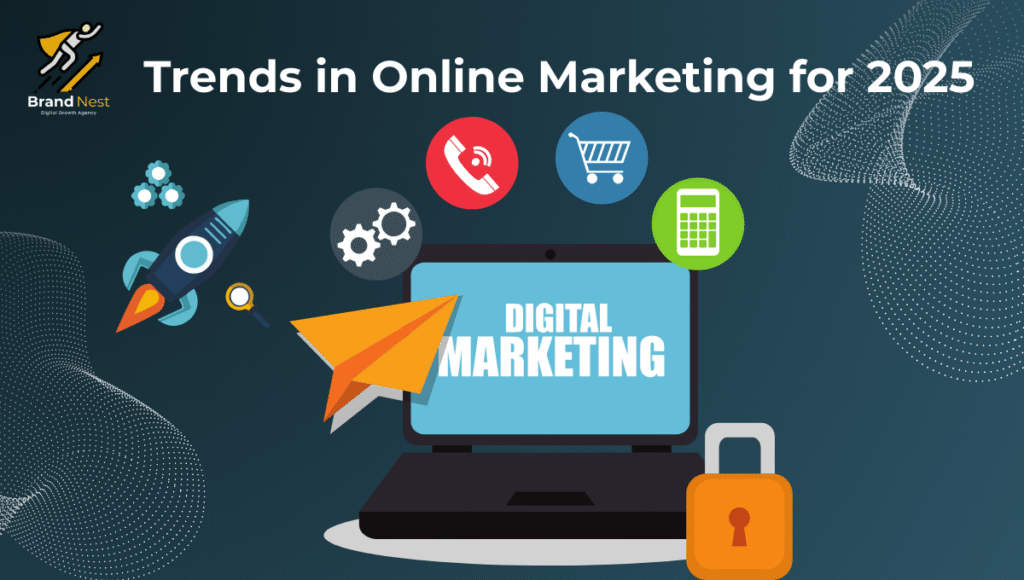
The digital marketing landscape continues to evolve rapidly, shaped by emerging technologies, changing consumer behavior, and shifting global markets. As we enter 2025, businesses are faced with both opportunities and challenges in navigating the competitive online space. To remain relevant and achieve growth, marketers must stay ahead of new trends that are redefining how brands connect with their audiences. Below are the most significant online marketing trends to watch in 2025.
1. Artificial Intelligence and Predictive Marketing
Artificial Intelligence (AI) is no longer a futuristic concept—it has become the backbone of modern digital strategies. In 2025, AI is enabling businesses to deliver hyper-personalized experiences by analyzing consumer behavior, purchase history, and engagement patterns.
Predictive marketing, powered by AI, allows companies to anticipate customer needs before they arise. For example, e-commerce platforms can recommend products based on browsing history, while streaming services use AI to suggest content tailored to individual preferences. This level of personalization not only improves customer satisfaction but also increases conversion rates.
Businesses that integrate AI-driven tools—such as chatbots, recommendation engines, and automated email campaigns—are more likely to achieve efficiency, reduce costs, and build stronger customer loyalty.
2. Voice Search and Conversational Marketing
With the growing adoption of smart speakers and voice assistants, voice search has become a dominant mode of interaction. Consumers are increasingly using voice commands to find products, services, and information. By 2025, optimizing digital content for voice search is no longer optional but essential.
Marketers must adapt their SEO strategies to include natural language queries and conversational keywords. Additionally, conversational marketing—powered by AI-driven chatbots and virtual assistants—has become a crucial tool for engaging customers in real time. Businesses that provide instant, human-like responses are building stronger trust and reducing customer drop-offs.
3. Short-Form and Interactive Video Content
Video marketing has been a powerful trend for several years, but in 2025, short-form and interactive videos are leading the way. Platforms such as TikTok, Instagram Reels, and YouTube Shorts have changed how audiences consume content, favoring quick, engaging, and mobile-friendly formats.
In addition, interactive videos—where viewers can click, choose outcomes, or engage directly—are gaining popularity. This format increases user engagement and provides valuable insights into consumer behavior. Brands that invest in storytelling through video are not only boosting visibility but also building deeper emotional connections with their audiences.
4. Social Commerce and Shoppable Content
Social media platforms are no longer just places for connection—they have become powerful marketplaces. In 2025, social commerce continues to rise as consumers prefer seamless shopping experiences within their favorite apps. Instagram, TikTok, and Facebook now offer integrated shopping features that allow users to purchase products without leaving the platform.
Shoppable posts, live-stream shopping events, and influencer collaborations are driving impulse buying and reducing friction in the purchasing journey. Businesses that embrace social commerce are gaining access to a wider audience and reducing the gap between discovery and purchase.
5. Privacy, Transparency, and Ethical Marketing
With increasing concerns around data privacy, consumers in 2025 demand greater transparency from brands. Stricter data protection regulations, combined with the phasing out of third-party cookies, have forced marketers to rethink how they collect and use customer information.
Businesses are now focusing on first-party data strategies, building trust through value-driven exchanges such as loyalty programs, gated content, and personalized offers. Ethical marketing—where brands openly communicate how data is used—has become a key differentiator in building long-term customer relationships.
6. Influencer Marketing 2.0
Influencer marketing has matured significantly. While earlier strategies focused on large-scale influencers, 2025 has seen a rise in micro and nano influencers who have smaller but highly engaged audiences. Consumers increasingly value authenticity over popularity, and niche creators are providing brands with more targeted and cost-effective partnerships.
Additionally, virtual influencers—AI-generated personalities with lifelike features—are becoming a trend, offering brands new creative opportunities to connect with tech-savvy audiences. The emphasis is now on creating meaningful, long-term collaborations rather than one-off sponsored posts.
7. Sustainability and Purpose-Driven Marketing
Today’s consumers, particularly younger generations, prefer brands that demonstrate social responsibility and environmental awareness. In 2025, businesses are incorporating sustainability into their marketing strategies by highlighting eco-friendly practices, ethical sourcing, and social contributions.
Purpose-driven campaigns that align with consumer values are building deeper emotional bonds. Brands that ignore these expectations risk losing credibility and market share. As a result, sustainability messaging is no longer a marketing trend but an essential component of brand identity.
8. Omnichannel Customer Experience
The modern consumer expects a seamless journey across multiple touchpoints, from websites and mobile apps to physical stores and social media platforms. Omnichannel marketing strategies are crucial in 2025, ensuring that every interaction feels consistent and personalized.
For example, a customer might research a product on Instagram, compare prices on a website, and complete the purchase in a store. Businesses that integrate these experiences using customer relationship management (CRM) tools and AI-driven insights are achieving stronger brand loyalty and higher retention rates.
9. The Rise of Augmented and Virtual Reality
Augmented Reality (AR) and Virtual Reality (VR) are transforming how consumers interact with products online. From virtual try-on experiences in fashion and beauty to immersive real estate tours, AR and VR are bridging the gap between digital and physical shopping.
In 2025, brands that leverage AR/VR are not only enhancing customer experience but also reducing returns and building greater confidence in online purchases. This trend is particularly valuable in industries where physical interaction with the product has traditionally been important.
Conclusion
The online marketing landscape in 2025 is shaped by technology, personalization, and a deeper emphasis on ethics and values. Businesses must adapt quickly to AI-driven personalization, voice search optimization, social commerce, and emerging technologies such as AR and VR. At the same time, maintaining consumer trust through transparency, ethical practices, and sustainability is critical for long-term success.
Brands that embrace these trends and prioritize customer-centric strategies will not only stay ahead of competitors but also foster lasting connections with their audiences. The future of online marketing belongs to businesses that combine innovation with authenticity, ensuring they remain relevant in an increasingly dynamic digital world.


